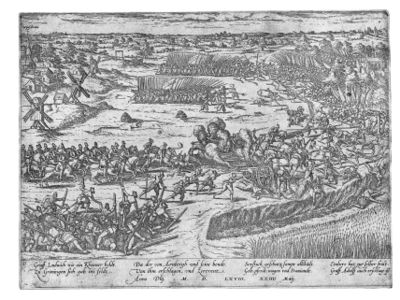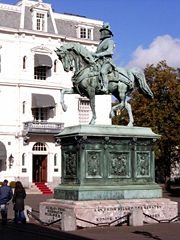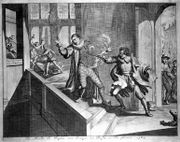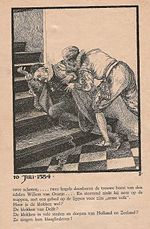William the Silent
2008/9 Schools Wikipedia Selection. Related subjects: Historical figures
|
William I , Prince of Orange
|
|
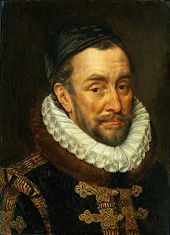 William the Silent |
|
|
Stadtholder of Holland, Zeeland, Utrecht, Friesland
Leader of the Dutch Revolt |
|
| In office 1559 – 1584 |
|
|
Stadtholder of Holland, Zeeland, and Utrecht
|
|
| In office 1559 – 1567 (removed from office after flight) |
|
| Monarch | Philip II of Spain |
|---|---|
|
Stadtholder of Holland, Zeeland, and Utrecht (reinstated by States General)
|
|
| In office 1572 – 1584 (assassination) |
|
|
Republican Stadtholder of Friesland
|
|
| In office 1580 – 1584 (assassination) |
|
|
|
|
| Born | April 24, 1533, Dillenburg, Nassau, Holy Roman Empire (now Germany) |
| Died | July 10, 1584 (aged 51), Delft, Netherlands |
William I, Prince of Orange ( April 24, 1533 – July 10, 1584), also widely known as William the Silent (Dutch: Willem de Zwijger), or simply William of Orange, was born into the House of Nassau as a count of Nassau-Dillenburg. He became Prince of Orange in 1544 and is thereby the founder of the branch House of Orange-Nassau. He was the main leader of the Dutch revolt against the Spanish that set off the Eighty Years' War and resulted in the formal independence of the United Provinces in 1648.
A wealthy nobleman, William originally served at the court of Margaret of Parma, governor of the Spanish Netherlands. Unhappy with the lack of political power for the local nobility and the Spanish persecution of Dutch Protestants, William joined the Dutch uprising and turned against his former masters. The most influential and politically capable of the rebels, he led the Dutch to several military successes in the fight against the Spanish. Declared an outlaw by the Spanish king in 1580, he was assassinated by Balthasar Gérard (also written as 'Gerardts') in Delft at a time when William's popularity was waning.
There are several explanations for the origin of this nickname "William the Silent". The most common one is that he rarely spoke out clearly on controversial matters at the court or in public, or (by some accounts) even completely avoided speaking about such topics. In the Netherlands, he is also known as the Vader des Vaderlands, " Father of the Fatherland", and the Dutch national anthem, Het Wilhelmus, was written in his honour.
Early life
William was born in the castle of Dillenburg in Nassau, present-day Germany. He was the eldest son of William, Count of Nassau and Juliana of Stolberg-Werningerode, and was raised a Lutheran. He had four younger brothers and seven younger sisters: John, Hermanna, Louis, Mary, Anna, Elisabeth, Katharine, Juliane, Magdalene, Adolf and Henry.
When his cousin, René of Châlon, Prince of Orange, died childless in 1544, the eleven-year-old William inherited all Châlon's property, including the title Prince of Orange and vast estates in the Netherlands (present-day Netherlands and Belgium). Because of his young age, Holy Roman Emperor Charles V served as the regent of the principality until William was fit to rule. However, Charles V demanded that William receive a Roman Catholic education. William was sent to Brussels to study under the supervision of Mary of Habsburg (aka Mary of Hungary), the sister of Charles V and governor of the Habsburg Netherlands ( Seventeen Provinces). In Brussels, he was taught foreign languages and received military and diplomatic education.
On 6 July 1551, he married Anna van Egmond en Buren, the wealthy heir to the lands of her father, and William earned the titles Lord of Egmond and Count of Buren. They had three children. Later that same year, William was appointed captain in the cavalry. Favoured by Charles V, he made quick promotions, and became commander of one of the Emperor's armies at age 22. He was made a member of the Raad van State, the highest political advisory council in the Netherlands in 1555; the same year Charles abdicated in favour of his son, Philip II of Spain. It was on the shoulder of William that the gout-afflicted Emperor leaned during his abdication ceremony.
His wife Anna died on March 24, 1558. Later, William had a brief relationship with one Eva Elincx, leading to the birth of their illegitimate son, Justinus van Nassau: William officially recognised him and took responsibility for his education — Justinus would become an admiral in his later years.
In 1559, Philip appointed William as the stadtholder (governor) of the provinces Holland, Zeeland, Utrecht and Burgundy, thereby greatly increasing his political power.
From politician to rebel
Although he never directly opposed the Spanish king, William soon became one of the most prominent members of the opposition in the Raad van State, together with Philip de Montmorency, Count of Hoorn and Lamoral, Count of Egmont. They were mainly seeking more political power for the Dutch nobility, and complained that too many Spaniards were involved in governing the Netherlands. William was also dissatisfied with the increasing persecution of Protestants in the Netherlands. Brought up as both a Lutheran and later a Catholic, William was very religious but still was a proponent of freedom of religion for all people. The inquisition policy in the Netherlands, carried out by Cardinal Granvelle, prime minister to the new governor Margaret of Parma ( 1522– 83) (natural half-sister to Philip II), increased opposition to the Spanish rule among the — then mostly Catholic — population of the Netherlands.
On 25 August 1561, William of Orange married for the second time. His new wife, Anna of Saxony, was described by contemporaries as "self-absorbed, weak, assertive, and cruel", and it is generally assumed that William married her to gain more influence in Saxony, Hesse and the Palatine. The couple had five children. In early 1565, a large group of lesser noblemen, including William's younger brother Louis, formed the Confederacy of Noblemen. On 5 April, they offered a petition to Margaret of Austria, requesting an end to the persecution of Protestants. From August to October 1566, a wave of iconoclasm (known as the Beeldenstorm) spread through the Low Countries. Calvinists, angry with their being persecuted by the Roman Catholic Church and opposed to the Catholic images of saints (which in their eyes conflicted with the Second Commandment), destroyed statues in hundreds of churches and monasteries throughout the Netherlands.
Following the Beeldenstorm, unrest in the Netherlands grew, and Margaret agreed to grant the wishes of the Confederacy, provided the noblemen would help to restore order. She also allowed more important noblemen, including William of Orange, to assist the Confederacy. In late 1566, and early 1567, it became clear that the she would not be allowed to fulfill her promises, and when several minor rebellions failed, many Calvinists (the major Protestant denomination) and Lutherans fled the country. Following the announcement that Philip II, unhappy with the situation in the Netherlands, would dispatch his loyal general Fernando Álvarez de Toledo, Duke of Alba (also known as "The Iron Duke") to restore order, William laid down his functions and retreated to his native Nassau in April 1567. He had been (financially) involved with several of the rebellions.
After his arrival in August 1567, Alba established the Council of Troubles (known to the people as the Council of Blood) to judge those involved with the rebellion and the iconoclasm. William was one of the 10,000 to be summoned before the Council, but he failed to appear. He was subsequently declared an outlaw, and his properties were confiscated. As one of the most prominent and popular politicians of the Netherlands, William of Orange emerged as the leader of an armed resistance. He financed the Watergeuzen, refugee Protestants who formed bands of corsairs and raided the coastal cities of the Netherlands (often killing Spanish and Dutch alike). He also raised an army, consisting mostly of German mercenaries to fight Alba on land. William allied with the French Huguenots, following the end the second Religious War in France when they had troops to spare. Led by his brother Louis, the army invaded the northern Netherlands in 1568. However the plan failed almost from the start. The Huguenots were defeated by French Royal Troops before they could invade, and a small force under Jean de Villers was captured within two days. Villers gave all the plans to the campaign to the Spanish following this capture. On 23 May, the army under the command of Louis won the Battle of Heiligerlee in the northern province of Groningen against a Spanish army led by the stadtholder of the northern provinces, Jean de Ligne, Duke of Aremberg. Aremberg was killed in the battle, as was William's brother Adolf. Alba countered by killing a number of convicted noblemen (including the Counts of Egmont and Hoorn on 6 June), and then by leading an expedition to Groningen. There, he annihilated Louis’ forces on German territory in the Battle of Jemmingen on 21 July, although Louis managed to escape. These two battles are now considered to be the start of the Eighty Years' War.
War
William responded by leading a large army into Brabant, but Alba carefully avoided a decisive confrontation, expecting the army to fall apart quickly. As William advanced, riots broke out in his army, and with winter apporaching and money running out, William decided to turn back. William made several more plans to invade in the next few years, but little came of it, lacking support and money. He remained popular with the public, partially through an extensive propaganda campaign through pamphlets. One of his most important claims, with which he attempted to justify his actions, was that he was not fighting the rightful owner of the land, the Spanish king, but only the inadequate rule of the foreign governors in the Netherlands, and the presence of foreign soldiers. On April 1, 1572 a band of Watergeuzen captured the city of Brielle, which had been left unattended by the Spanish garrison. Contrary to their normal "hit and run" tactics, they occupied the town and claimed it for the prince by raising the Prince of Orange's flag above the city. This event was followed by other cities in opening their gates for the Watergeuzen, and soon most cities in Holland and Zeeland were in the hands of the rebels, notable exceptions being Amsterdam and Middelburg. The rebel cities then called a meeting of the Staten Generaal (which they were technically unqualified to do), and reinstated William as the stadtholder of Holland and Zeeland.
Concurrently, rebel armies captured cities throughout the entire country, from Deventer to Mons. William himself then advanced with his own army and marched into several cities in the south, including Roermond and Leuven. William had counted on intervention from the French Protestants ( Huguenots) as well, but this plan was thwarted after the St. Bartholomew's Day Massacre on 24 August, which signalled the start of a wave of violence against the Huguenots. After a successful Spanish attack on his army, William had to flee and he retreated to Enkhuizen, in Holland. The Spanish then organised countermeasures, and sacked several rebel cities, sometimes massacring their inhabitants, such as in Mechelen or Zutphen. They had more trouble with the cities in Holland, where they took Haarlem after seven months and a loss of 8,000 soldiers, and they had to give up their siege of Alkmaar.
In 1574, William's armies won several minor battles, including several naval encounters. The Spanish, now lead by Don Luis de Zúñiga y Requesens whom Philip had replaced Alba with in 1573, also had their successes, and their decisive victory in the Battle of Mookerheyde in the south east, on the Meuse embankment, on 14 April cost the lives of two of William's brothers, Louis and Henry. Requesens's armies also besieged the city of Leiden. They broke up their siege when nearby dykes were cut by the Dutch. William was very content with the victory, and established the University of Leiden, the first university in the Northern Provinces. William married for the third time on 24 April 1575. He had his previous marriage legally disbanded in 1571, on claims of insanity of his wife Anna. Charlotte de Bourbon-Monpensier, a former French nun, was also popular with the public. Together, they had six daughters.
After failed peace negotiations in Breda in 1575, the war lingered on. The situation improved for the rebels when Don Requesens died unexpectedly in March 1576, and a large group of Spanish soldiers, not having received their salary in months, mutinied in November of that year and unleashed the Spanish Fury on the city of Antwerp, a tremendous propaganda coup for the Dutch Revolt. While the new governor, Don John of Austria, was under way, William of Orange managed to have most of the provinces and cities sign the Pacification of Ghent, in which they declared to fight for the expulsion of Spanish troops together. However, he failed to achieve unity in matters of religion. Catholic cities and provinces would not allow freedom for Calvinists, and vice versa.
When Don John signed the Perpetual Edict in February 1577, promising to comply with the conditions of the Pacification of Ghent, it seemed that the war had been decided in favour of the rebels. However, after Don John took the city of Namur in 1577, the uprising spread throughout the entire Netherlands. Don John attempted to negotiate peace, but the prince intentionally let the negotiations fail. On 24 September 1577, he made his triumphal entry in the capital Brussels. At the same time, Calvinist rebels grew more radical, and attempted to forbid Catholicism in their areas of control. William was opposed to this both for personal and political reasons. He desired freedom of religion, and he also needed the support of the less radical Protestants and Catholics to reach his political goals. On 6 January 1579, several southern provinces, unhappy with William's radical following, sealed the Treaty of Arras, in which they agreed to accept their governor, Alessandro Farnese, Duke of Parma (who had succeeded Don John).
Five northern provinces, later followed by most cities in Brabant and Flanders, then signed the Union of Utrecht on 23 January, confirming their unity. William was initially opposed to the Union, as he still hoped to unite all provinces. Nevertheless, he formally gave his support on 3 May. The Union of Utrecht would later become a de facto constitution, and would remain the only formal connection between the Dutch provinces until 1795.
Declaration of independence
In spite of the renewed union, the Duke of Parma was successful in reconquering most of the southern part of the Netherlands. Because he had agreed to remove the Spanish troops from the provinces under the Treaty of Arras, and because Philip II needed them in Spain's war with Portugal, the Duke of Parma was unable to advance any further until the end of 1581. In the mean time, William and his supporters were looking for foreign support. The prince had already sought for French assistance on several occasions, and this time he managed to gain the support of François, Duke of Anjou, brother of king Henry III of France. On September 29, 1580, the Staten Generaal (with the exception of Zeeland and Holland) signed the Treaty of Plessis-les-Tours with the Duke of Anjou. The Duke would gain the title "Protector of the Liberty of the Netherlands" and become the new sovereign. This, however, required that the Staten Generaal and William would let go of their formal support of the King of Spain, which they had maintained officially up to that moment.
On July 22, 1581, the Staten Generaal declared their decision to no longer recognise Philip II as their king, in the Act of Abjuration. This formal declaration of independence enabled the Duke of Anjou to come to the aid of the resisters. He did not arrive until February 10, 1582, when he was officially welcomed by William in Flushing. On March 18, the Spaniard Juan de Jáuregui attempted to assassinate William in Antwerp. Although William suffered severe injuries, he survived thanks to the care of his wife Charlotte and his sister Mary. While William slowly recovered, the intensive care by Charlotte took its toll, and she died on May 5. The Duke of Anjou was not very popular with the population. In their view, the French were enemies, and the Duke of Anjou was not very concerned with the people's religious issues. The Duke was even accused of planning Jáuregui's failed attempt to kill the prince. The provinces of Zeeland and Holland refused to recognise him as their sovereign, and William was widely criticised for what were called his "French politics". When the Anjou's French troops arrived in late 1582, William's plan seemed to pay off, as even the Duke of Parma feared that the Dutch would now gain the upper hand.
However, the Duke of Anjou himself was displeased with his limited power, and decided to take the city of Antwerp by force on January 18, 1583. The citizens, who were warned in time, defended their city in what is known as the " French Fury". The position of Anjou after this attack became impossible to hold, and he eventually left the country in June. His leave also discredited William, who nevertheless maintained his support for Anjou. He stood virtually alone on this issue, and became politically isolated. Holland and Zeeland nevertheless maintained him as their stadtholder, and attempted to declare him count of Holland and Zeeland, thus making him the official sovereign. In the middle of all this, William had married for the fourth and final time on April 12, 1583 to Louise de Coligny, a French Huguenot and daughter of Gaspard de Coligny. She would be the mother of Frederick Henry (1584–1647), William's fourth legitimate son.
Assassination
The Catholic Frenchman Balthasar Gérard (born 1557) was a supporter of Philip II, and in his opinion, William of Orange had betrayed the Spanish king and the Catholic religion. After Philip II declared William an outlaw and promised a reward of 25,000 crowns for his assassination, which Gérard found out in 1581, he decided to travel to the Netherlands to kill William. He served in the army of the governor of Luxembourg, Peter Ernst I von Mansfeld-Vorderort for two years, hoping to get close to William when the armies met. This never happened, and Gérard left the army in 1584. He went to the Duke of Parma to present his plans, but the Duke was unimpressed. In May 1584, he presented himself to William as a French nobleman, and gave him the seal of the Count of Mansfelt. This seal would allow for forgeries of messages of Mansfelt. William sent Gérard back to France to pass the seal to his French allies.
Gérard returned in July, having bought pistols on his return voyage. On 10 July, he made an appointment with William of Orange in his home in Delft, nowadays known as the Prinsenhof. When William left the dining room and climbed down the stairs, Gérard shot him in the chest from close range, and fled. According to British historian of science Lisa Jardine, he is reputed to be the first world head of state assassinated through use of a handgun. According to official records, his last words are said to have been:
| “ | Mon Dieu, ayez pitié de mon âme; mon Dieu, ayez pitié de ce pauvre peuple." | ” |
-
-
- ("My God, have pity on my soul; my God, have pity on this poor people.")
-
Members of the Nassau family were traditionally buried in Breda, but as that city was in Spanish hands when William died, he was buried in the New Church (Nieuwe Kerk) in Delft. His grave monument was originally very sober, but it was replaced in 1623 by a splendid new one, made by Hendrik de Keyser and his son Pieter. Since then, most of the members of the House of Orange-Nassau, including all Dutch monarchs have been buried in the same church. His great-grandson William the third, King of England and Scotland and Stadtholder in the Netherlands was buried in Westminster Abbey
Gérard was caught before he could flee Delft, and imprisoned. He was tortured before his trial on 13 July, where he was sentenced to be brutally — even by the standards of that time — killed. The magistrates sentenced that the right hand of Gérard should be burned off with a red-hot iron, that his flesh should be torn from his bones with pincers in six different places, that he should be quartered and disemboweled alive, that his heart should be torn from his bosom and flung in his face, and that, finally, his head should be cut off.
Legacy
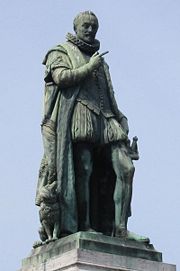
At the suggestion of Johan van Oldenbarneveldt, William's eldest son from his first marriage, to Anna of Egmond, Philip William, succeeded him as Prince of Orange. Phillip William died in Brussels on February 20, 1618 and was succeeded by his half-brother Maurice, the eldest son from William's second marriage, to Anna of Saxony, who became Prince of Orange. A strong military leader, he won several victories over the Spanish. Van Oldenbarneveldt managed to sign a very favourable twelve-year armistice in 1609, although Maurice was unhappy with this. Maurice was a heavy drinker and died on April 23, 1625 from liver disease. Maurice had several sons with Margaretha van Mechelen, but he never married her. So, Frederick Henry, Maurice's half-brother (and William's youngest son from his fourth marriage, to Louise de Coligny) inherited the title of Prince of Orange. Frederick Henry continued the battle against the Spanish. Frederick Henry died on March 14, 1647 and is buried with his father William "The Silent" in Nieuwe Kerk, Delft. The Netherlands became formally independent after the Peace of Westphalia in 1648.
The son of Frederick Henry, William II of Orange succeeded his father as stadtholder, as did his son, William III of Orange. The latter also became king of England, Scotland and Ireland from 1689. Although he was married to Mary II, Queen of Scotland and England for 17 years, he died childless in 1702. He appointed his cousin Johan Willem Friso (William's great-great-great-grandson) as his successor. Because Albertine Agnes, a daughter of Frederick Henry, married William Frederik of Nassau-Dietz, the present royal house of the Netherlands descends from William the Silent through the female line. See House of Orange for a more extensive overview. As the chief financer and political and military leader of the early years of the Dutch revolt, William is considered a national hero in the Netherlands, even though he was born in Germany, and usually spoke French. Many of the Dutch national symbols can be traced back to William of Orange:
- The flag of the Netherlands (red, white and blue) is derived from the flag of the prince, which was orange, white and blue.
- The coat of arms of the Netherlands is based on that of William of Orange. Its motto Je maintiendrai (French, "I will maintain") was also used by William of Orange, who based it on the motto of his cousin René of Châlon, who used Je maintiendrai Châlon.
- The national anthem of the Netherlands, Het Wilhelmus, was originally a propaganda song for William. It was probably written by Philips van Marnix, lord of Sint-Aldegonde, a supporter of William of Orange.
- The national colour of the Netherlands is orange, and it is used, among other things, in clothing of Dutch athletes.
- The Prussian Order of the Black Eagle was in honour of the Dutch Dynasty of William the Silent.
- A statue of William the Silent stands at the main campus of Rutgers University in New Brunswick, New Jersey, a legacy of the university's founding by ministers of the Dutch Reformed Church in 1766.
- In January 2008, a planetoid was named after him.
Issue
| Name | Birth | Death | Notes |
|---|---|---|---|
| By Anna of Egmond (married 6 July 1551; b. est 1534, d. 24 March 1558) | |||
| Countess Maria von Nassau. | 22 Nov 1553 | ca. 23 Jul 1555 | Died in infancy, no issue |
| Philip William, Prince of Orange | 19 Dec 1554 | 20 Feb 1618 | married Eleanor of Bourbon, no issue |
| Countess Maria of Nassau | 7 Feb 1556 | 10 Oct 1616 | married Count Philipp zu Hohenlohe-Neuenstein, one male child |
| By Anna of Saxony (married 25 August 1561 annulled 22 March 1571; b. 23 December 1544, d. 18 Dec 1577) | |||
| Countess Anna I von Nassau | 31 Oct 1562 | 23 Nov 1562 | Died in infancy |
| Countess Anna II von Nassau | 5 Nov 1563 | 13 Jun 1588 | married Count Wilhelm Ludwig von Nassau-Dillenburg |
| Maurice August Phillip von Nassau | 18 Dec 1564 | 8 Dec 1566 | Count, Died in infancy, no issue |
| Maurice of Nassau, Prince of Orange |
14 Nov 1567 | 23 Apr 1625 | never married |
| Countess Emilia of Nassau | 10 Apr 1569 | 16 Mar 1629 | married Manuel I of Portugal (son of pretender to the Portuguese throne António, Prior of Crato), 10 children |
| By Charlotte of Bourbon (married 24 June 1575; b. about 1546, d. 5 May 1582) | |||
| Countess Louise Juliana of Nassau | 31 March 1576 | 15 March 1644 | married Frederick IV, Elector Palatine, 8 children |
| Countess Elisabeth of Nassau | 1577 | 1642 | married to Henri de La Tour d'Auvergne, and had issue, including Frédéric Maurice, duc de Bouillon and Henri de la Tour d'Auvergne, Vicomte de Turenne |
| Catharina Belgica of Nassau | 1578 | 1648 | Countess, married to Count Phillip Ludwig II of Hanau-Münzenberg |
| Charlotte Flandrina of Nassau, Sister |
1579 | 1640 | After her mother's death in 1582 her French grandfather asked for Charlotte Flandrina to stay with him. She became a Roman Catholic and entered a convent in 1593. |
| Charlotte Brabantina of Nassau | 1580 | 1631 | married Claude, Duc de Thouars, and had issue, including Charlotte Stanley, Countess of Derby. |
| Emilia Antwerpiana of Nassau | 1581 | 1657 | married Frederick Casimir, Count Palatine of Zweibrücken-Landsberg |
| By Louise de Coligny (married 24 April 1583; b. 23 Sep 1555, d. 13 November 1620) | |||
| Frederick Henry, Prince of Orange and Count of Nassau |
b. 29 Jan 1584 | d. 14 Mar 1647 | married to Countess Amalia of Solms-Braunfels, father of William II and grandfather of William III, King of England, Scotland, Ireland and Stadtholder of the Netherlands |
Between his first and second marriage, William had an extramarital relation with one Eva Elincx. They had a son, Justinus van Nassau (1559–1631), whom William acknowledged.
